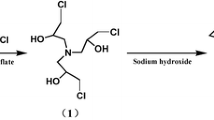Abstract
Soy isolate was treated with formaldehyde and glyoxal at 1.0, 2.5, and 5.0% (w/w isolate) and with adipic and acetic anhydrides. The materials were then compression-molded into plastic tensile bars and tested for tensile and yield strength, percentage elongation, Young's modulus, and water absorption. Treatment with 5% formaldehyde increased the tensile strength significantly, to 4.9 kg/mm2, compared with the untreated sample (3.7 kg/mm2). The yield strength increased slightly, to 0.68 kg/mm2. Elongation was significantly less after treatment with formaldehyde. Young's modulus increased after treatment and leveled off at 174 kg/mm2. Water absorption decreased as the formaldehyde concentration increased. Treatment with either glyoxal or adipic/acetic anhydride had a detrimental effect on the mechanical properties of the plastic specimens. Water absorption was decreased by glyoxal treatment but was not affected by adipic/acetic anhydride treatment. Long-fiber (lf), short-fiber (sf), and microcrystalline (mc) cellulose were incorporated into soy isolate at various levels. Cellulose addition decreased the percentage elongation and increased the rigidity of the plastic. All three cellulose additions increased Young's modulus. The tensile strength increased with the addition of sf-cellulose to soy isolate; lf-cellulose decreased the tensile strength, whereas the incorporation of mc-cellulose did not have a significant effect. The yield strength increased slightly with the addition of sf-cellulose and was less affected by the addition of lf- or mc-cellulose. All three types of cellulose slightly decreased water absorption at ca. 15% content.
Similar content being viewed by others

References
J. Jane, S.-T. Lim, and I. Paetau (1994) in D. Kaplan, E. Thomas, and C. Ching (Eds.),Fundamentals of Biodegradable Polymers and Materials, Technomic, Lancaster, PA pp. 63–70.
S.-T. Lim and J. Jane (1993) in M. Yalpani (Ed.),Carbohydrates and Carbohydrate Polymers, ATL Press, Mount Prospect, IL, pp. 288–297.
G. Lay, J. Rehm, R. F. Stepto, M. Thoma, J.-P. Sachetto, D. J. Lentz, and J. Silbiger (1992) U.S. Patent 5,095,054.
G. H. Brother and L. L. McKinney (1938)Ind. Eng. Chem. 30(11), 1236–1240.
L. A. Johnson, D. J. Myers, and D. J. Burden (1992)Inform 3(3), 282–290.
I. Paetau, C.-Z. Chen, and J. Jane, (1994)Ind. Eng. Chem. Res. 33, 1821–1827.
P. J. Barham and A. Keller (1986)J. Polym. Sci. Polym. Phys. Ed. 24, 69–77.
C. Butcher (1990)Chem. Eng. 474 (May 24), 15.
P. A. Holmes (1985)Phys. Technol. 16, 32–36.
M. Scandola, M. Pizzoli, and G. Ceccorulli (1988)Int. J. Biol. Macromol. 10, 373–377.
B. J. Wiley, D. H. Ball, S. M. Arcidiacono, S. Sousa, J. M. Mayer, and D. L. Kaplan (1993)J. Environ. Polym. Degrad. 1(1), 3–9.
H. Preusting, J. Kingma, G. Huisman, A. Steinbuechel, and B. Witholt (1993)J. Environ. Polym. Degrad. 1(1), 11–21.
D. Jendrossek, I. Knoke, R. B. Habibian, A. Steinbuechel, and H. G. Schlegel (1993)J. Environ. Polym. Degrad. 1(1), 53–63.
J. Bjorksten (1951)Adv. Protein Chem. 6, 343–358.
H. Fraenkel-Conrat and H. S. Olcott (1948)J. Am. Chem. Soc. 70(8), 2673–2684.
A. F. S. A. Habeeb and R. Hiramoto (1968)Arch. Biochem. Biophys. 126, 16–26.
J. H. Bowes and C. W. Cater (1966)J. Roy Microsc. Soc. 85(4), 193–200.
P. Gatenholm, J. Kubat, and A. Mathiasson (1992)J. Appl. Polym. Sci. 45, 1667–1677.
L. L. McKinney, R. Deanin, G. Babcock, and A. K. Smith (1943)Ind. Eng. Chem. 35(8), 905–908.
T. P. Nevell and S. H. Zeronian (Eds.) (1985)Cellulose Chemistry and Its Application, Ellis Horwood, Chichester, West Sussex, England.
N. L. Salmen (1985) in T. P. Nevell and S. H. Zeronian (Eds.),Cellulose Chemistry and Its Application, Ellis Horwood, Chichester, West Sussex, England, pp. 505–530.
O. B. Wurzburg (1960) U.S. Patent 2,935,510.
H. Huang (1994)Properties of Biodegradable Plastics Made from Chemically Modified Soy Protein, M.S. Thesis, Iowa State University, Ames.
D. J. Sessa (1992)Lebensm.-Wiss. u.-Technol. 25, 365–370.
Author information
Authors and Affiliations
Additional information
Journal Paper No. J-15563 of the Iowa Agriculture and Home Economics Experiment Station, Ames; Project No. 2863.
Rights and permissions
About this article
Cite this article
Paetau, I., Chen, C.Z. & Jane, J. Biodegradable plastic made from soybean products. II. Effects of cross-linking and cellulose incorporation on mechanical properties and water absorption. J Environ Polym Degr 2, 211–217 (1994). https://doi.org/10.1007/BF02067447
Issue Date:
DOI: https://doi.org/10.1007/BF02067447



